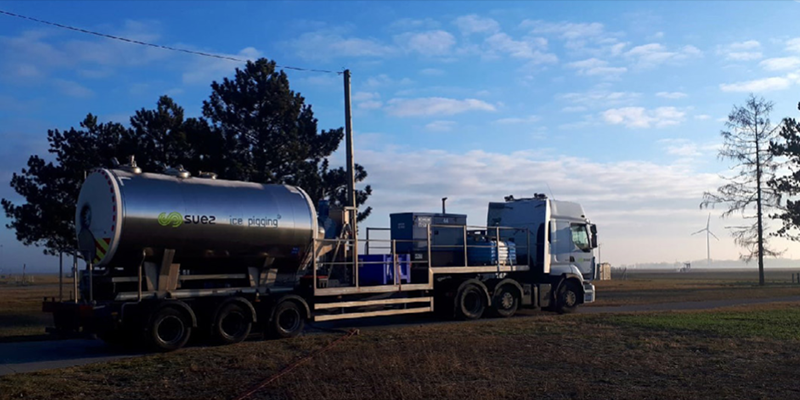Ice pigging on the Austria Prottes ring main
Publicerad: 3 september, 2021

OMV had recently installed a new water treatment plant at Gänserndorf, to treat brine produced from the oilfield, before its re-injection into the Prottes Ringschluss network.
Despite the excellent water quality produced at the plant, historic build-up of iron sulphide in the distribution pipes was causing significant pressure losses across the network and water quality issues at a nearby polymer plant.
Traditional pigging would have required costly enabling works, as well as network down time during the pigging process, so OMV approached SUEZ to discuss applying its Ice PiggingTM technology. This was one of the first field applications in the oil and gas sector.
The 8,500 m network mainly consisted of a DN250 and DN200 ring main and some smaller diameter branch pipes feeding individual injection wells. The pipework was broken into seven separate sections for Ice PiggingTM, ranging from 800 m to 1,750 m in length. In most sections the ice slurry could be inserted and removed by adapting existing network fittings, so very few enabling works were required.
SUEZ manufactured all ice locally, using its mobile ice generation system which was set up at Gänserndorf treatment plant. The normal network operating temperatures are 35oC, so OMV arranged for tankers of cool water to be inserted before the ice, to reduce melting during the operation.
Due to the close communication and planning between SUEZ and OMV, the operations went very smoothly. The longest operation took just 31⁄2 hours and many took less than two, after which the injection network was immediately returned to service.
Effluent samples analysed by OMV show that significant quantities of iron sulphide and bacterial growth were removed from the pipework; in some cases in excess of 500 kg from sections with average length of 1,000 m.
The removal of this material resulted in hydraulic improvements in the network, including a 0.5 bar increase at the end of the network. There was also a pronounced improvement in the flows observed on the small diameter pipes feeding the injection wells, with some seeing increases of 30% after Ice PiggingTM.
How It Works
Ice PiggingTM is a pipeline cleaning process utilising a two-phase ice slurry which forms a semi-solid ‘pig’ within the pipe. The slurry is pumped into the main like a liquid, but when moving through the pipework it behaves like a solid material; detaching contaminants and fouling from the pipe wall and carrying them out of the pipe entrained within the ice pig.
The pig is pushed through the section by the network pressure, so the pipe is under no additional stress. The process can be undertaken on all pipe materials, at diameters of up to 600 mm and on sections several kilometers in length. Ice PiggingTM cleans in a single pass, so is incredibly fast and water efficient, as well as requiring no harmful chemicals.
Differentiating factors include:
• Ice PiggingTM has the benefits of foam pigging, but without any of the associated hazards
• The ice slurry is inserted and ejected using small diameter existing fittings
• The Ice PigTM flows through complex pipework such as bends, changes in diameter and butterfly valves
• Minimum outage times; most pipes are cleaned in a few hours
• In the unlikely event of becoming stuck, the ice can be left to melt
• Existing section valves and pump inlet valves can be used to control the ice pig velocity and movement easily.
Ice PiggingTM has proven to be very effective at removing iron sulphide and bacterial growth from produced water injection networks in the oil industry. Suez is confident that similar results can be achieved in other oil industry applications.